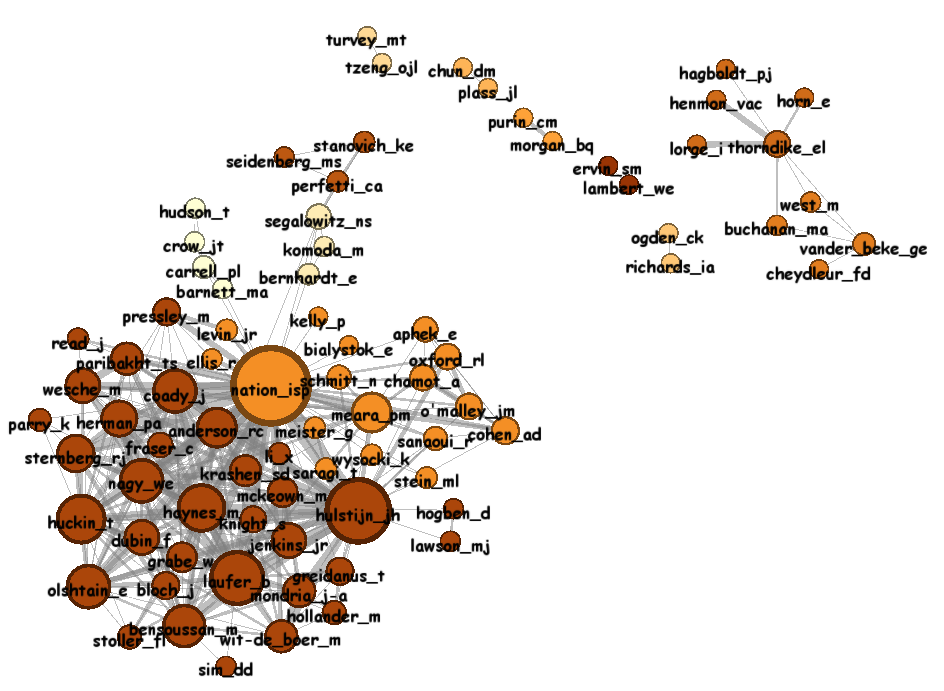
_lognostics maps The Modern Language Journal
2006
MLJ
in prep
2002
Applied Linguistics

data source: The Modern Language Journal data analysis: November 2011
data: 201 papers, 102 nodes, 335 co-citations, 12 clusters
threshold for inclusion: Authors must be cited in at least five different papers.
This map graphs the co-citations generated by the vocabulary research published in The Modern Language Journal between 1916 and 2010.
102 authors are cited in at least five papers in this 94 year period.
Their work falls into twelve clusters, which have a strong chronological dimension.
Cluster I links the work of 34 people: Hulstijn, Laufer, Haynes, Huckin, Coady, Olshtain, Bensoussan, Nagy, Pressley, Wesche, Paribakht, Parry, Herman, Anderson, Sternberg, Fraser, Krashen, Li,Hogben, Lawson,Jenkins, Knight,Dubin, Grabe, Bloch, Mondria, Wit-de Boer, Greidanus, Hollander, Stoller and Sim.
This unusually dense cluster seems to represent the mainstream work on vocabulary teaching published in the Journal in the period 1990-2010. A significant characteristic of this cluster is a focus on reading in a second language. Members of this cluster all tend to be cited along with Nation.
Cluster II, the central cluster dominated by Nation links 17 people: Nation, Meara, Chamot, Oxford, Aphek, O'Malley, Cohen, Saragi, Meister, Wysocki, Stein, Sanaoui, Schmitt, Bialystok, Kelly, Levin, and Rod Ellis. This cluster seems to be less focussed on vocabulary teaching than is cluster I, and more concerned with theories of vocabulary learning. The members of this cluster are all cited alongside Nation, but are not otherwise strongly linked with the members of Cluster I.
Cluster III - Barnett, Carrell, Crow and Hudson - is an L2 reading cluster that was flourishing in the 1980s, but is not much cited in more recent work.
Cluster IV and Cluster V - Bernhardt, Komoda, Segalowitz, Perfetti, Seidenberg and Stanovich - are psychologists concerned with the L2 performance. These groups are concerned with formal experimental approaches to L2 vocabulary, providing some serious theoretical input into the two main clusters.
The remaining clusters are disconnected from the main cluster group, and represent strands in the MLJ research which have now largely been forgotten - at least as far as the MLJ is concerned.
Cluster VI, Purin and Morgan, Cluster VII, Thorndike, Lorge, Henmon, Hagboldt, and Horn, and Cluster VIII, West, Buchanan, vander Beke and Cheydleur, represent early attempts to develop standardised word lists for the major European Languages, and to explore the implications of these lists for foreign language education. Frequency counts figured largely in this work. Cluster IX, Ogden and Richards, is an alternative to frequency counts built around the BASIC English program. These clusters are very influential in the early volumes of the Modern Langauge Journal, but their influence declines steadily after the 1939-45 World War.
Cluster X, Ervin and Lambert, captures the brief flowering of psycholinguistic and sociolinguistic approaches to bilinguals that appeared in the 1960s, but was not developed by further work in this journal.
Cluster XI, Chun and Plass, is broadly concerned with text comprehension in an L2, while Cluster XII, Turvey and Tzeng is a cluster that is concerned with reading in non-roman scripts.
